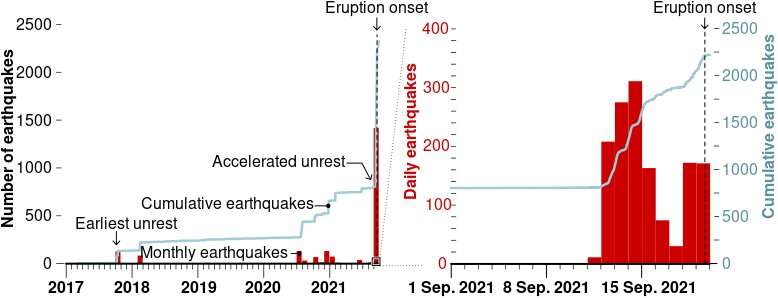December 3, 2021 report
Environmental scientist suggests lessons can be learned from unexpected eruption of Cumbre Vieja

Environmental scientist Marc-Antoine Longpré with City University of New York is suggesting in a Perspective piece published in the journal Science that lessons can be learned from the unexpected eruption of Cumbre Vieja last fall. In his paper, he notes that the timing, explosive power and effusiveness of the blast caught most vulcanologists off guard.
Cumbre Vieja is a currently active volcano situated on the island of La Palma in the Canary Islands. Its latest eruption began September 19 and is ongoing. In his paper, Longpré suggests that the reason scientists were caught off guard by the blast was because some island systems, such as those in the Canary Islands, behave differently than other volcanoes. He suggests Cumbre Vieja and others in the area "defy global relationships" regarding the period when they are quiet versus when they erupt. Data from monitors on the island suggests that the volcano may have been in the process of priming for an eruption for as long as four years.
Cumbre Vieja had been asleep for approximately 50 years before it suddenly woke and blew its top last fall. But its eruption was not unexpected—the volcano had erupted six times since 1500, with dormant periods ranging from 24 to 237 years. And like prior dormant periods, there had been periodic seismic events. Six low level earthquakes had been recorded between the years 2000 and 2016. Also, there was an earthquake swarm in 2017—128 tiny earthquakes were recorded over eight days; an interesting event, but not divergent enough to suggest the volcano was going to blow three years later.
In similar fashion, 84 tiny earthquakes were recorded in early 2018. Still, it did not suggest that the volcano was moving toward an eruption, at least by standards set for volcanoes in other places, especially after the volcano went quiet for the next two and a half years. Then there were a couple of smaller swarms before things really changed. On September 11, 2021, earthquake patterns increased and were coming from more shallow depths, and ground deformations appeared. This was enough to send out warnings to locals. Eight days later, the volcano erupted.
Longpré suggests that there are lessons to be learned from the Cumbre Vieja eruption, and that they will likely be centered on recognition of the fact that not all volcanoes provide the same kinds of warning signs—particularly those in the Canary Islands.
More information: Marc-Antoine Longpré, Reactivation of Cumbre Vieja volcano, Science (2021). DOI: 10.1126/science.abm9423
Journal information: Science
© 2021 Science X Network




















